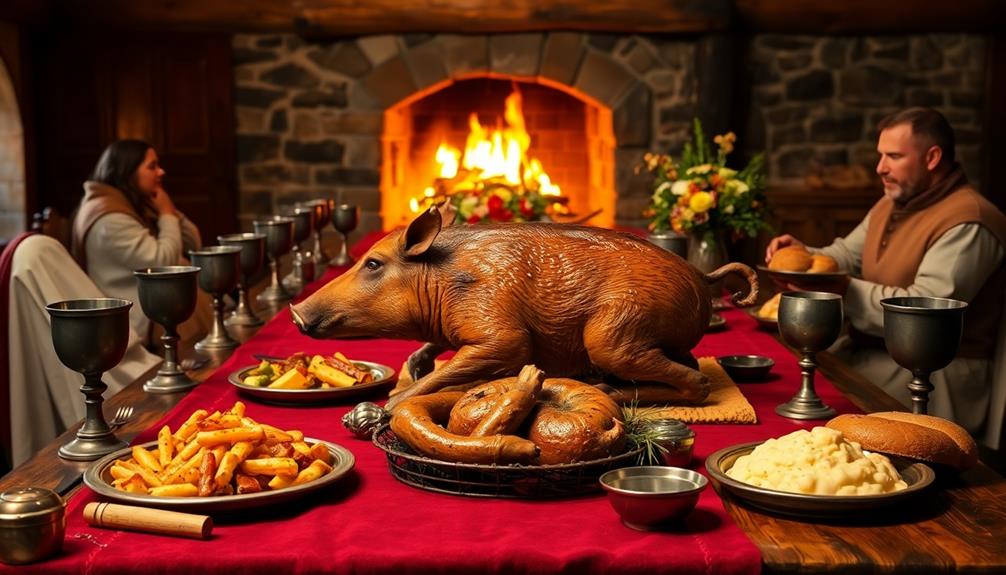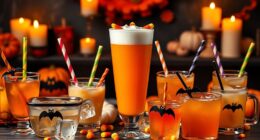Halloween foods worldwide have roots in ancient Celtic and European traditions, where foods like soul cakes, pumpkin-shaped treats, and carved lanterns symbolized protection, remembrance, and connection with spirits. These foods often carry cultural meanings tied to folklore, serving as storytelling tools, talismans, or offerings. Over time, native and immigrant influences blended, creating seasonal favorites like candy apples and pumpkin goodies. To discover how these customs evolved and varied across cultures, keep exploring their fascinating history.
Key Takeaways
- Halloween foods originate from Celtic festivals like Samhain, where offerings honored spirits and reinforced community bonds.
- Pumpkin-based treats and jack-o’-lanterns stem from Irish folklore, symbolizing protection and the supernatural.
- In North America, native and immigrant traditions merged, creating treats like caramel apples and pumpkin-flavored goodies.
- Foods often mimic supernatural themes, serving as symbols, talismans, or storytelling tools rooted in centuries-old customs.
- Globally, Halloween foods reflect diverse cultural beliefs about spirits, protection, and honoring ancestors through festive edibles.

Halloween foods have a rich history that varies across cultures, reflecting local traditions and beliefs. As you explore these treats and dishes, you’ll discover how deeply they’re intertwined with costume traditions and folklore origins. Many of the foods associated with Halloween weren’t just about sustenance—they served as symbols, talismans, or storytelling tools rooted in centuries-old customs. For example, in Ireland and Scotland, the origins of Halloween foods are closely linked to ancient Celtic festivals like Samhain, where people believed that the boundary between the living and the dead blurred. During these times, foods like soul cakes became popular; these sweet treats were offered to the spirits and the poor in exchange for prayers, reinforcing community bonds and honoring ancestors. Such foods often carried symbolic meaning, representing remembrance and protection against malevolent spirits.
In many cultures, Halloween foods also reflect costume traditions that have evolved over time. The act of dressing up was initially meant to disguise oneself from wandering spirits or to impersonate ancestors. This practice influenced the kinds of foods prepared, often featuring ingredients that mimicked the supernatural or the grotesque. For instance, in Victorian England, it was common to prepare spooky-looking treats such as pumpkin-shaped cakes or ghostly meringues, tying the visual aspect of costumes to the edible domain. These foods reinforced the themes of disguise and transformation, key elements of the holiday’s folklore origins. You might notice that many Halloween dishes aim to evoke a sense of mystery or fright, similar to the costumes worn during festivities.
Across North America, Halloween foods have incorporated a variety of influences, blending native traditions with immigrant customs. Candy apples, caramel-dipped treats, and pumpkin-flavored goodies became staples, often inspired by harvest festivals and the folklore surrounding pumpkin patches. Pumpkins, in particular, symbolize the folklore origins of Halloween, as they were carved into lanterns—jack-o’-lanterns—meant to ward off evil spirits. The tradition of carving pumpkins was believed to originate from an Irish myth about Stingy Jack, and the lanterns served as a protective charm, much like the costume traditions meant to confuse or scare away spirits. These foods and symbols are more than just seasonal fare—they’re tangible links to centuries-old stories about good versus evil, life versus death, and the supernatural domain. Additionally, the use of natural materials like pumpkins and gourds in decorations echoes the rustic aesthetic characteristic of farmhouse-inspired Halloween setups.
In essence, Halloween foods serve as edible expressions of the holiday’s folklore origins and costume traditions. They carry stories, beliefs, and customs from around the world, allowing you to connect with centuries of history through flavors and visual cues. As you enjoy these treats, remember that they’re not just about taste—they’re part of a larger cultural narrative that celebrates the mysterious, the supernatural, and the communal spirit of Halloween.
Frequently Asked Questions
How Did Halloween Foods Originate in Ancient Cultures?
You can see that Halloween foods originated from ancient cultures as part of their rituals and cultural symbolism. These foods, like carved pumpkins or special breads, often symbolized offerings to spirits or used in ceremonies to honor ancestors. By incorporating these foods into celebrations, ancient peoples believed they could protect themselves from evil spirits, connect with the supernatural, and honor their traditions, laying the foundation for modern Halloween treats.
Which Countries Have the Oldest Halloween Food Traditions?
They say “old habits die hard,” and you’ll find that Ireland and Scotland have some of the oldest Halloween food traditions. You might enjoy their pumpkin carving festivals and candy distribution customs, which date back centuries. These countries kept alive ancient practices, blending foods with spooky festivities. As you explore, you’ll see how their rich history influences modern Halloween treats, making every celebration a delicious link to the past.
Are There Specific Ingredients Unique to Halloween Foods Worldwide?
You’ll notice that Halloween foods often feature specific ingredients like pumpkin spices and popular candy types. Pumpkin spices, such as cinnamon, nutmeg, and cloves, add a warm, festive flavor to treats, while candy types like chocolates, gummies, and lollipops create a fun, sweet experience. These ingredients are somewhat unique to Halloween, reflecting the season’s flavors and traditions, making your celebrations more festive and memorable.
How Have Halloween Food Traditions Evolved Over Centuries?
You’ve witnessed how Halloween food traditions have evolved through the centuries, blending cultural influences and modern adaptations. Once simple offerings like apples and nuts now feature elaborate treats, spooky decorations, and themed desserts. As you indulge, consider how centuries of change have shaped these customs, transforming age-old practices into a vibrant, global celebration. This evolution keeps the holiday exciting, constantly reinventing itself while honoring its mysterious, historical roots.
What Are the Regional Variations in Halloween Food Customs?
You’ll notice regional variations in Halloween food customs shaped by cultural influences and local ingredients. In the U.S., you might enjoy pumpkin-shaped treats and caramel apples, while in Mexico, calaveras (sugar skulls) and pan de muerto reflect Day of the Dead traditions. In Ireland, black pudding and potato-based dishes are common, showing regional ingredients. These customs highlight how local culture and ingredients influence Halloween celebrations worldwide.
Conclusion
As you carve your pumpkin and indulge in Halloween treats, remember that these foods are like ancient whispers, echoing centuries of tradition across the globe. They’re more than just sweets or snacks; they’re the flavorful threads weaving together stories of cultures, rituals, and history. So, as you celebrate tonight, let each bite be a delicious portal into the rich tapestry of Halloween’s culinary past, where every flavor tells a ghostly tale waiting to be discovered.









